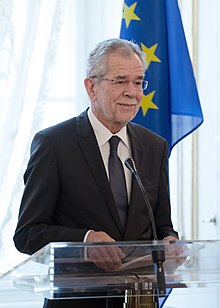President of Austria
| President of Austria | |
|---|---|
| Bundespräsident der Republik Österreich | |
 | |
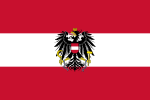 | |
since 26 January 2017 | |
| Executive branch in Austrian Politics Presidential Chancellery | |
| Style | Mr. President (normally) His Excellency (diplomatic) |
| Type | Head of State |
| Status | Supreme executive organ |
| Residence | Leopoldine Wing, Hofburg Imperial Palace |
| Seat | Innere Stadt, Vienna |
| Nominator | Political parties or self-nomination |
| Appointer | Direct popular vote sworn in by the Federal Assembly |
| Term length | Six years, renewable once |
| Constituting instrument | Constitution of Austria |
| Precursor | President of the Constituent National Assembly |
| Formation |
|
| First holder | Michael Hainisch |
| Salary | €349,398 annually |
| Website | www.bundespraesident.at |
| This article is part of a series on the |
| Politics of Austria |
|---|
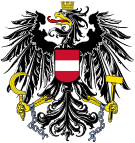 |
The president of Austria (Template:Lang-de) is the head of state of the Austrian Republic. Though theoretically entrusted with great power by the Constitution, in practice the president is largely a ceremonial and symbolic figurehead.
The president is directly elected by universal suffrage every six years and can continuously remain in office for twelve years. The president is – along with the ministers, state secretaries and members of state cabinets – a supreme executive organ. One of the best known and most important presidential tasks is the appointment of the chancellor and, upon his advice, the other members of Cabinet.
The president ranks first in Austria's order of precedence, being ahead of the president of the National Council and the chancellor. Presidential workplaces are located in the Leopoldine Wing of the Hofburg Imperial Palace in Vienna.
The office of President was formed by the Constitution on 1 October 1920. The constitutional amendment of 1929 established that the president was to be elected by the people. Nevertheless, the re-election of President Wilhelm Miklas in 1931 was conducted by the Federal Assembly. Even Karl Renner was still elected by the Federal Assembly in 1945. Ultimately, Theodor Körner became the first president to be elected by the people in 1951.
Most presidents have gained tremendous popularity while in office, and no president has ever lost a bid for re-election, although Kurt Waldheim did not run for a second term. Five presidents have died in office. From 2004 to 2016, the office was occupied by social democrat Heinz Fischer. Since the formation of the popular vote in 1951, only members and nominees of the Social Democratic Party and the People's Party had been elected President, until the election of the Green-endorsed incumbent Alexander Van der Bellen in 2016.
History
Prior to the collapse of the multinational Austro-Hungarian Empire towards the end of World War I, what now is the Republic of Austria had been part of a monarchy with an emperor as its head of state and chief executive. The empire noticeably began to fracture in late 1917 and manifestly disintegrated into a number of independent states over the course of the following year.
Effective 21 October 1918, the Imperial Council parliamentarians representing the empire's ethnically German provinces formed a Provisional National Assembly for their paralyzed rump state and appointed veteran party leader Karl Seitz as one of their three largely coequal chairmen (21 October 1918 – 16 February 1919). As chairman, he became an ex officio member of the State Council (Deutschösterreichischer Staatsrat). On 12 November 1918, the State Council collectively assumed the functions of head of state according to a resolution of the National Assembly.
On 11 November, Emperor Charles I announced "I relinquish every participation in the administration of the State. Likewise I have released the members of the Austrian Government from their offices".[1] The next day, parliament proclaimed the Republic of German-Austria. The assembly presidents (Seitz, Franz Dinghofer and Johann Nepomuk Hauser) continued to serve as acting heads of state until 4 March 1919, when the Constituent National Assembly collectively assumed these functions. Seitz (5 March 1919 – 10 November 1920) was the only President of the Constituent National Assembly.
Karl Seitz performed the duties of head of state according to a law of 1 October 1920, which transferred these duties to the "former president of the National Constituent Assembly" for the period from 10 November 1920, to the day of inaugurating the first president (9 December 1920). Since Austria had not finalized its decision to structure itself as a federation prior to the formal promulgation of the Constitution of Austria on 1 October 1920, referring to Seitz as president would have been inaccurate. Austria's first Bundespräsident proper thus was Michael Hainisch, Karl Seitz' immediate successor. In a related note, many popular sources quote some more or less random date between October 1918 and March 1919 as the beginning of Seitz' tenure. While most of them are merely misleading, others are plainly wrong: even though Seitz was appointed president of the Provisional National Assembly in October 1918, it would have been impossible for him to serve as Bundespräsident, since the republic has not even been proclaimed back-then.
The constitution originally defined Austria to be a parliamentary republic. Originally, the constitution was radically parliamentarian in character. The bicameral parliament, called the Federal Assembly, not only possessed legislative power, but also a good deal of executive power as well. The president was elected by both houses of the Federal Assembly for a term of four years. He was answerable to the Federal Assembly, and his role was almost entirely ceremonial. In particular, he did not have the power to appoint the government, a power reserved to the National Council, and had no authority to dissolve the National Council. He did not even have much actual influence on the appointment of Constitutional Court justices.
The role and nature of the president was the result of a compromise reached during the drafting of the constitution. The Christian Socials wanted a president with executive powers similar to those of the president of Germany. However, the Social Democrats, fearing that such a president would become an "ersatz emperor," would have preferred that the president of the National Council double as head of state. In the end, the framers created a separate presidency in accordance with the wishes of the Christian Socials. However, to appease the Social Democrats, he lacked even nominal executive authority. It was under this constitutional framework that Michael Hainisch and Wilhelm Miklas assumed office on 9 December 1920 and 10 December 1928, respectively.
The parliamentary system prescribed by the constitution was highly unpopular, however, with the authoritarian Heimwehr movement evolving during the 1920s. The Heimwehr was in favor of a system granting more powers to the president. On 7 December 1929, under growing pressure from the Heimwehr, the constitution was amended to give the president sweeping executive and legislative powers. Although most of these powers were to be exercised through the ministers, on paper the president now had powers equivalent to those of presidents in presidential systems. It also called for the office to be filled by popular vote for a term of six years. He also had the power to appoint the cabinet. The first election was scheduled for 1934. However, owing to the growing worldwide financial crisis, all parties agreed to suspend the election in favour of having Miklas reelected by parliament.
Only three years later, however, the Fatherland Front – an alliance of the Heimwehr and the Christian Social Party – tore down Austrian parliamentarism altogether, formally annulling the constitution on 1 May 1934. It was replaced by an authoritarian/corporatist document that concentrated power in the hands of the Chancellor, not those of the president. Wilhelm Miklas was stripped of the powers he'd gained in 1929, but agreed to act as a figurehead of institutional continuity anyway. He was not entirely powerless, however; during the Anschluss crisis, he provided some of the stiffest resistance to the Nazi demands.[2] He technically remained in office until 13 March 1938, the day Austria was annexed by Nazi Germany and thus lost sovereignty.
When Austria re-established itself as an independent state on 27 April 1945, the party leaders forming the provisional government decided not to frame a new constitution, reverting instead to that of 1920, as amended in 1929. Even though this revision was still somewhat controversial at that point, it was part of Austria's most recent constitutional framework, giving it at least some much-needed form of democratic legitimacy. The party leaders were also afraid that lengthy discussion might provoke the Red Army then in control of Vienna to barge in and impose Communist rule. The constitution thus reenacted effective 1 May therefore still included the provision calling for popular election of the president. Following the November 1945 National Council elections, however, the National Assembly temporarily suspended this provision and installed Karl Renner as the president of Austria as of 20 December. The suspension in question seems to have been motivated mainly by lack of cash: no attempt was ever made to prolong it, and the benign septuagenarian Renner had been the universally respected provisional head of state anyway. Starting with the 1951 election of Renner's successor Theodor Körner, all presidents have in fact been elected by the people.
Election
Procedure
The president of Austria is elected by popular vote for a term of six years and is limited to two consecutive terms of office.[3][4][5] Voting is open to all people entitled to vote in general parliamentary elections, which in practice means that suffrage is universal for all Austrian citizens over the age of sixteen that have not been convicted of a jail term of more than one year of imprisonment. (Even so, they regain the right to vote six months after their release from prison.)
Until 1 October 2011, with the exception of members of any ruling or formerly ruling dynastic houses (a measure of precaution against monarchist subversion, and primarily aimed at members of the House of Habsburg), anyone entitled to vote in elections to the National Council who is at least 35 years of age is eligible for the office of president. The exception of ruling or formerly ruling dynasties has been abolished meanwhile within the Wahlrechtsänderungsgesetz 2011 (Amendment of the law on the right to vote 2011) due to an initiative by Ulrich Habsburg-Lothringen.[6]
The president is elected under the two-round system. This means that if no candidate receives an absolute majority (i.e. more than 50%) of votes cast in the first round, then a second ballot occurs in which only those two candidates who received the greatest number of votes in the first round may stand. However the constitution also provides that the group that nominates one of these two candidates may instead nominate an alternative candidate in the second round. If there is only one candidate standing in a presidential election then the electorate is granted the opportunity to either accept or reject the candidate in a referendum.
While in office the president cannot belong to an elected body or hold any other position.
Oath of office
Article 62 of the Austrian Constitution provides that the president must take the following oath or affirmation of office in the presence of the Federal Assembly (although the addition of a religious asseveration is admissible):
"I solemnly promise that I shall faithfully observe the Constitution and all the laws of the Republic and shall fulfill my duty to the best of my knowledge and conscience."
Latest elections
Powers and duties
Presidential powers and responsibilities are chiefly established by the Federal Constitutional Law,[7][8] additional powers may be defined by federal statute, judicial interpretations and legal precedents. While the Austrian political system as a whole can often be compared with that of Germany, the Austrian presidency can hardly be compared with the German one, but rather much more with the British monarchy; since both are head of state, appoint the head of government and their cabinet, can dismiss the head of government and their cabinet, appoint the highest-ranking government officials, sign bills into law, and are the military commanders-in-chief of their country.
Powers of appointment
Cabinet

The President appoints the Chancellor and, upon their advice, the other members of the cabinet as well as the State Secretaries.[9] The President is not bound to any legal provisions or specifications when appointing the Chancellor. However, since the National Council is empowered to impeach and remove individual members of cabinet or even the entire cabinet at any time, through a motion of no confidence, it is de facto impossible for a President to keep a government in office against the will of the National Council.
Until the year 2000, convention called for the President to entrust the leader of the largest party with the formation of a new cabinet. As the cabinet formation of 2000 has shown, the President cannot enforce the existence of a minority government. In practice, the initiative of forming a new cabinet can therefore entirely be subject to interested parties. Since every member of cabinet is appointed by the President (on advice of the Chancellor), the President can yet always refuse to appoint a nominated Minister or State Secretary.
So far, there have been only three cases in which a President declined to appoint a nominee for cabinet. Karl Renner rejected a Minister suspected of corruption for re-appointment. Thomas Klestil declined to appoint two ministers; one of the them having been involved in a criminal case and the other had been frequently noticed for extremist and xenophobic statements during the election campaign. In 1953, President Theodor Körner discarded the demands of Chancellor Leopold Figl to appoint a cabinet with the participation of the Federation of Independents.
Federal officers
The president appoints the federal officials, including military officers, judges and other functionaries.[10] These powers can be, and usually are, delegated to the ministers.[11] Supreme organs, however, are appointed by the president himself.
The president also swears in the governors of the states following their election in a state diet, this is because governors do not only serve as the chief executives of their respective states but also as the chief representatives of the federal government within that state.
Powers of dismissal
Cabinet
The President can dismiss the Chancellor or the entire cabinet at their own discretion. However, the dismissal of individual cabinet members requires the advice of the Chancellor. So far, the dismissal of an entire cabinet against its will has never occurred. President Wilhelm Miklas did not make use of this power when Chancellor Engelbert Dollfuß overturned the Constitution to establish the Federal State of Austria.
Powers of dissolution
National Council
The President may dissolve the National Council at the request of cabinet, but only once for the same reason.[12] The legal consequences of a dissolution of the National Council by the President differ from those of a parliamentary self-dissolution. If the President terminates the legislative period, the National Council is immediately dissolved and thus incapacitated. However, the Standing Subcommittee of the National Council's Principal Committee remains as an emergency organ until the newly elected National Council convenes. Prior to that, the President may issue emergency decrees on the request of the government and with the consent of the standing subcommittee of the principal committee. In case of self-dissolution, the old National Council meets until a new one is elected.
So far only Wilhelm Miklas has made use of the dissolution right, after the Christian Social Party had lost its coalition partner and thus the majority in parliament. Since the following legislative election was not in the interest of the government, the instrument of presidential dissolution of parliament was not applied.
State diets
The president can dissolve every Landtag (state legislature) at the request of the government and with the consent of the Federal Council.[13] However, he may only do so once for the same reason – as with the dissolution of the National Council. The Federal Council must agree to the dissolution with a two-thirds majority. The representatives of the state whose Landtag is to be dissolved may not take part at the vote.
The dissolution of a Landtag is regarded as a direct intervention of the federal government in the autonomy of the states. As in the case of the dissolution of the National Council by the president, a dissolved Landtag is considered incapable of action until its newly elected successor meets. This power has never been used by any president yet.
Legislative role
Signing bills into law
As state notary of the republic, the president signs bills into law.[14] Signing bills into law is a constitutionally mandated duty of the president and not a discretionary power; it is not comparable with the presidential veto in the United States or the Royal Assent in the United Kingdom. In their capacity as state notary, the president scrutinises the constitutionality of the lawmaking process, undertaken to enact a piece of legalisation. If the president finds the bill to have been crafted in an unconstitutional way, the president is ought to "fail" to sign; meaning that the president is compelled to deny signature, which strikes down the bill. All bills on federal level, no matter if they affect statutory or even constitutional law, must be signed by the president to take effect.
The president generally does not verify if an enacted statute complies with constitutional law; that is subject to the Constitutional Court, once the statute becomes effective and is legally challenged. Although judicial interpretations regarding the scrutiny extent of this presidential responsibility have varied, with some arguing that the president may deny signature if provisions of an enacted statute are undoubtedly unconstitutional. President Heinz Fischer established a precedent for that, by refusing to sign a statute – containing retrospective criminal provisions – into law; this remains the only time a president has denied signature.
Once a bill is introduced in Parliament, it must pass the National Council with the requisite quorums and be approved by the Federal Council to become 'enacted'.[15] After its enactment the bill is forwarded to the chancellor, who submits it to the president. The president then signs the bill into law, that is, if it has been enacted in accordance with constitutional requirements.[16] The chancellor subsequently countersigns and then promulgates the bill in the federal law gazette, ultimately rendering it effective.[17][18]
If the president refuses to sign any or particular bills into law – that are not in obvious and direct violation of constitutional law – the president may be impeached by the Federal Assembly before the Constitutional Court and subsequently removed from office through conviction for violating the Constitution.
Rule by decree
The president is authorized to rule by emergency decree in times of crisis.[19] The Constitution states as follow:
"to ward off irreparable damages to the general public, at a time where the National Council is not in session and cannot be convened in time, at the request of the cabinet, and with the assent of the Standing Subcommittee of the Principal Committee of the National Council, the president is empowered to adopt provisional regulations that have the force of law".
Such emergency decrees do not affect the Constitution – which chiefly consists of the Federal Constitutional Law and the Basic Human Rights – as well as any other important legal provision. As soon as the National Council is in session again, it is ought to immediately approve or invalidate active emergency decrees. The power to rule by decree has never been applied yet.
Judicial role
Executor of the Constitutional Court
The president is entrusted with the execution of findings of the Constitutional Court in cases that are not subject to ordinary courts.[20] The request for execution is lodged by the Constitutional Court itself. The constitution provides the head of state with extensive enforcement rights. Execution jurisdiction can encompass state and federal authorities as well as a state or the republic in its entirety. Therefore the president can issue direct orders to all federal and state authorities, including the armed forces and the police. If a federal organ or the republic as a whole are affected, the president's directives do not require countersignature.
Appointing justices
The president appoints the president, the vice president, the six further justices, and the three substitute justices of the Constitutional Court on the nomination of Cabinet; additionally, the president appoints one justice and three substitute justices on the nomination of the National Council and one justice and three substitute justices on the nomination of the Federal Council.[21] The president also appoints the president, the two vice presidents, the 14 presiding justices, and the 43 further justices of the Supreme Court of Justice; as well as the president, the vice president, the presiding justices, and the further justices of the Supreme Administrative Court on the nomination of Cabinet, of which all members expect the president and vice president are recommended to Cabinet by the Court itself.[22]
Diplomatic role
The president is the chief diplomat of Austria and may negotiate and sign treaties with foreign countries; some treaties require the assent of the National Council.
When Austria joined the European Union, President Thomas Klestil and Chancellor Franz Vranitzky had a disagreement on who would represent Austria in the European Council. Ultimately, the chancellor's point of view prevailed, mainly due to legal and practical reasons. However, President Klestil argued that he had only delegated this power of representation to the chancellor.
Commander-in-chief
The president is the commander-in-chief of the Austrian Armed Forces,[23] a role the president derived from the constitutional amendment of 1929. While there is no unanimous juridical or scholarly consensus regarding the amendment's interpretation, the role is widely considered a very powerful reserve right.
Article 80 of the Constitution establishes how the military is to be governed. Clause 1 of that article states "the President shall hold Supreme Command over the Armed Forces", Clause 2 states "if not the President has disposal authority over the military, as established by the Defense Law, the minister responsible [Minister of Defense] shall have disposal authority within a scope of responsibility defined by the Cabinet", and Clause 3 states that "command authority over the military shall be exercised by the minister responsible [Minister of Defense]".[24]
The Constitution therefore distinguishes between three different types of military authority: "disposal authority" (=Verfügungsgewalt), which entails one to define the structures, tasks, and missions of the Armed Forces or individual military units; "command authority" (=Befehlsgewalt), which grants one the plain right to issue verbal or written military orders; and "supreme command" (=Oberbefehl), which elevates one to the peak of military hierarchy.[25] The latter one (which Clause 1 grants exclusively to the president) has particularly been ambiguous and inconclusive. However, the majority of constitutional scholars – including Constitutional Court president Ludwig Adamovich – believe that the president in this capacity, outranks the minister of defense and all military personnel.[26]
Since no president has ever made use of this power, legal precedents were never established. The military's day-to-day operations are overseen and administered by the minister of defense, who serves as the chief military officer of the armed forces and is broadly recognized as the de facto highest authority.[27][28] Key decisions on the use of the armed forces are usually made by the Cabinet.
As commander-in-chief, the president succeeds the emperor in his capacity as supreme commander of the Austro-Hungarian Military. Ensuing the end of the Habsburg monarchy in 1918, the Principal Committee of the National Council functioned as paramount decision-making authority of the then-newly established Bundesheer. In 1929, the Christian Social Party transferred supreme military command from the Principal Committee to the president through a constitutional amendment, in order to advance fascism in Austria.
The president can definitely issue exceptional recruitment measures and possesses the right to be comprehensively informed.
Other powers and duties
The president also holds many other rights, which are typically part of the duties of a head of state. These include, for example, the creation and awarding of honorary and professional titles,[29] and the de facto meaningless right to declare illegitimate children to legitimate children at the request of the parents. Among the presidential rights, which were formed from simple federal laws, is the "Promotio sub auspiciis Praesidentis rei publicae", in which PhD students with extraordinary credentials receive a ring of honor from the president. In addition, the president has the right to shut down criminal proceedings (right of abolition) or to pardon prisoners. According to the case law of the Constitutional Court, pardon acts of the president do not only undo the punishment itself, but also the associated blame. Accordingly, a disciplinary process may no longer rely on such a conviction: "The repayment of a conviction granted by the grace of the president has the consequence that this conviction may no longer be considered in case of disciplinary proceedings".[30]
Criticism and scenarios
While the presidency is vested with immense power and is situated at the peak of the executive branch and the whole government itself, neither the president nor the chancellor possess the legal power to direct the executive branch. The true, legal heads of the executive branch are the ministers, who serve as the supreme executive organs of their respective ministries; in practice, the chancellor – and in a coalition also the vice chancellor – commands the ministers on a partisan basis.
Scholars, constitutional scholars, jurists, historians, political scientists, and the general public, have created various hypothetical scenarios on how the president could use their authority to become the chief executive or even de facto autocrat of the country, without violation constitutional law.
The most common scenario is that the president installs "marionette politicians", who will only abide by the president's will. This scenario typically commences with the president appointing a marionette chancellor, who will in turn nominate marionette ministers to the president, thereby establishing a marionette cabinet. A hitch to this scenario is the National Council, which can dismiss the chancellor, a minister, or the entire cabinet through a simple motion of no confidence. Furthermore, the National Council can practically immobilize the president by passing a request to convene the Federal Assembly to consider popular deposition, which will prevent the president from further exercising their authority; it is the only non-legislative power of the National Council over the president. However, the president can bypass such outcome by dissolving the National Council on the request of Cabinet. A presidential dissolution of the National Council is immediate and will trigger a new legislative election. The base scenario usually ends here, while there are various hypothetical continuations, such as the president making use of their military powers to disable Parliament, or the president appointing "marionette justices" to the Constitutional Court who can grant the president "unlimited executive power", all of these either end in the establishment of an unconstitutional dictatorship or in an endless cycle where either side seeks to prevail.
Incumbency
Immunity
The president enjoys full sovereign immunity from any type of official prosecution, including civil suit and criminal prosecution. The president may only be prosecuted with the explicit consent of the Federal Assembly. If a government authority intends to prosecute the president, it must refer a request for extradition to the National Council. If the National Council approves, the chancellor must convene the Federal Assembly, which will then decide over the request for extradition.[31]
Removal
Popular deposition
The ordinary way of removing a sitting president from office is through popular deposition. Since the president is elected by the people, the people also have the power to remove the president again through a plebiscite.[32]
Popular deposition commences with an act of the National Council requesting the convocation of the Federal Assembly. Such a resolution of the National Council is passed with a supermajority, meaning it requires the same quorums as when amending constitutional law; the attendance of at least half of the members of the National Council and a successful two-thirds vote. If passed, the president is automatically unable to "further exercise the powers and duties of the presidency" and thereby deprived of all authority, the chancellor in turn, is required to immediately call a session of the Federal Assembly. Once convened, the Federal Assembly then considers and decides over the National Council's request of administering a plebiscite.
If a plebiscite is conducted and turns out successful, the president is removed from office. However, if the plebiscite fails the Constitution treats it as a new legislative election, which triggers the immediate and automatic dissolution of the National Council; even in such a case, the president's term of office may not exceed twelve years in total.
Removal by court
The president can be indicted before the Constitutional Court by the Federal Assembly for violating constitutional law.[33] This process is triggered by either a resolution of the National Council or the Federal Council. Upon the passage of such a resolution, the chancellor is required to call a session of the Federal Assembly, which then considers the request of indictment. A supermajority is needed to indict the president, meaning the attendance of at least half of the members of the National Council and the Federal Council as well as a successful two-thirds vote are required.[34]
If the Federal Assembly decides to indict the president, it acts as the plaintiff before the Constitutional Court. If the Court finds the president to have committed a severe wrongdoing, the president is convicted and removed from office; conversely, if the Court finds the president to have committed a minor wrongdoing, the president remains in office and is merely reprimanded.
Succession
The Constitution of Austria makes no provisions for an office of vice president. Should the president become temporarily incapacitated – undergoes surgery, becomes severely ill, or visits a foreign country (excluding EU member states) – presidential powers and duties devolve upon the chancellor for a period of twenty days, although the chancellor does not become "acting president" during that time.
The powers and duties of the presidency devolve upon the Presidium of the National Council in the following three cases:
- The aforementioned period of twenty days expires, in which case the Presidium assumes presidential powers and duties on the twenty-first day.[35]
- The office is vacated because the president dies, resigns, or is removed from office, in which case the Presidium assumes presidential powers and duties immediately.
- The president is prevented from "further exercising the powers and duties of the presidency" because the National Council has requested the convocation of the Federal Assembly to consider popular deposition, in which case the Presidium also assumes presidential powers and duties immediately.
When exercising the powers and duties of the presidency, the three presiding officers of the National Council – forming the Presidium – act collectively as a collegiate body. If votes are divided equally, the higher-ranking presiding officer's vote prevails.
Compensation
The president is compensated for his or her service with 349,398 EUR annually, the chancellor in turn is compensated with 311,962 EUR annually.[36] This amount is particularly high when considering that the chancellor of Germany (€251,448),[37] the president of France (€179,000),[38] the prime minister of the United Kingdom (€169,284),[39] and the president of Russia (€125,973) receive a significantly lesser salary, although they are the chief executives of substantially larger countries; the Austrian president's salary is topped only by that of the president of the United States (€370,511).[40][41]
Residence
The principal residence and workplace of the president is the Leopoldine Wing in the Hofburg Imperial Palace, which is located in the Innere Stadt of Vienna.[42] The Leopoldine Wing is sometimes ambiguously referred to as the "Presidential Chancellery", like the government body. In practice, the president does not actually reside in the Hofburg but retains their personal home.
As its full name already divulges, the Hofburg is an edifice stemming from the times of the monarchy; it was built under Holy Roman Emperor Leopold I in the 13th century. Ensuing the fall of the monarchy and the formation of the republic, democratic institutions intentionally kept their distance from monarchic establishments and so the original residence of the president became the chancellery building. However, following a severe bombardment during World War II, the chancellery building became uninhabitable and the president had to find new lodging. The first president of the Second Republic, Karl Renner, deliberately chose the Leopoldine Wing; as its creation and history – in particular the interior design – was majorly influenced by Empress Maria Theresia, whose profile was generally favorable among the people at the time. The chancellery building was later renovated and now serves as the residence and workplace of the chancellor.
Today, the Leopoldine Wing harbours the offices of the Presidential Chancellery in its second and third floor. Additionally to the Hofburg, the president has a summer residence at their disposal, the Mürzsteg Hunting Lodge. However, the lodge hasn't been utilised for decades; former president Heinz Fischer even fruitlessly pledged to sell the building during his electoral campaigning.[43]
Protection
The president is particularly protected by special criminal law provisions. This includes in particular § 249 StGB, "Violence and dangerous threat against the president". The offense belongs to the fifteenth section of the Criminal Code, "Attacks on supreme state organs":
"Anyone who attempts to depose the president by force or by dangerous threats, or to coerce or prevent him from exercising his powers in general or in a certain way, is to be punished with one to ten years imprisonment."
The insult of the president in contrast to most offenses is not a private prosecution, but an authorization offense. Hence, the president does not have to act as a prosecutor in person, but delegate the right to prosecute to the prosecutor's office. An example of this is the so-called "Hump-Dump affair". The title "Bundespräsident" (=president) may – even with additions or in context with other designations – not be used by anyone other than the incumbent president, because of him being protected by law.
Presidential Chancellery
The president heads the Presidential Chancellery, a small executive branch organization with the purpose of aiding the president in exercising and carrying out their powers and duties.[44] The Presidential Chancellery shouldn't be confused with the Federal Chancellery, a substantially larger executive branch institution reporting to the chancellor.[45] The Presidential Chancellery is the only government body the president actually directs. Although the president has the constitutional right to also direct the Armed Forces, that power has never been applied yet. The term "Presidential Chancellery" is sometimes interchangeably used with "Leopoldine Wing", the seat of the president and the Presidential Chancellery. Chief operating officer and deputy chief operating officer of the Presidential Chancellery are the cabinet director and cabinet vice director respectively.[46]
List of presidents
The list beneath is a list of actual presidents of Austria,[47][48] which excludes the chancellors and colleges that temporarily exercised presidential powers and duties.
| Portrait | President | Lifespan | Took office | Left office | Political party | |
|---|---|---|---|---|---|---|
| First Republic (1918–1938) | ||||||
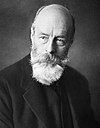
|
Michael Hainisch [49][50] |
15 August 1858 – 26 February 1940 | 9 December 1920 | 10 December 1928 | independent | |

|
Wilhelm Miklas [51] |
15 October 1872 – 20 March 1956 | 10 December 1928 | 13 March 1938 | CS | |
| Second Republic (since 1945) | ||||||

|
Karl Renner [52][53] |
14 December 1870 – 31 December 1950 | 20 December 1945 | 31 December 1950 | SPÖ | |

|
Theodor Körner [54] |
23 April 1873 – 4 January 1957 | 21 June 1951 | 4 January 1957 | SPÖ | |

|
Adolf Schärf [55] |
20 April 1890 – 28 February 1965 | 22 May 1957 | 28 February 1965 | SPÖ | |
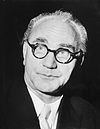
|
Franz Jonas [56] |
4 October 1899 – 24 April 1974 | 9 June 1965 | 24 April 1974 | SPÖ | |

|
Rudolf Kirchschläger [57] |
20 March 1915 – 30 March 2000 | 8 July 1974 | 8 July 1986 | independent (SPÖ nominated) | |

|
Kurt Waldheim [58] |
21 December 1918 – 14 June 2007 | 8 July 1986 | 8 July 1992 | independent (ÖVP nominated) | |

|
Thomas Klestil [59] |
4 November 1932 – 6 July 2004 | 8 July 1992 | 6 July 2004 | ÖVP independent | |
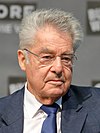
|
Heinz Fischer [60] |
born 9 October 1938 | 8 July 2004 | 8 July 2016 | SPÖ independent | |
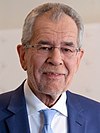
|
Alexander Van der Bellen [61][62] |
born 18 January 1944 | 26 January 2017 | Present | independent | |
See also
- History of Austria
- Politics of Austria
- Chancellor of Austria
- List of Chancellors of Austria
- Vice-Chancellor of Austria
- Emperor of Austria
References
- ^ "Emperor Karl I's Abdication Proclamation, 11 November 1918". firstworldwar.com. Retrieved 6 February 2014.
- ^ William Shirer, The Rise and Fall of the Third Reich (Touchstone Edition) (New York: Simon & Schuster, 1990)
- ^ "Wie wird man eigentlich Bundespräsident?". www.bundespraesident.at (in German). Retrieved 2020-03-29.
- ^ "Artikel 60 B-VG". www.ris.bka.gv.at (in German). Retrieved 2020-03-29.
- ^ "Art. 60 B-VG". www.jusline.at (in German). Retrieved 2020-03-29.
- ^ "Wahlrechtsänderungsgesetz" (PDF). www.ris.bka.gv.at (in German).
- ^ "Gesamte Rechtsvorschrift für Bundes-Verfassungsgesetz". www.ris.bka.gv.at (in German). Retrieved 2020-03-25.
- ^ "Der Bundespräsident, seine Aufgaben und Rechte". www.bundespraesident.at (in German). Retrieved 2020-03-25.
- ^ "Art. 70 B-VG". www.jusline.at (in German). Retrieved 2018-11-23.
- ^ "Art. 65 B-VG". www.jusline.at (in German). Retrieved 2018-11-25.
- ^ "Art. 66 B-VG". www.jusline.at (in German). Retrieved 2018-11-25.
- ^ "Art. 29 B-VG". www.jusline.at (in German). Retrieved 2018-11-23.
- ^ "Art. 100 B-VG". www.jusline.at (in German). Retrieved 2018-11-24.
- ^ "Art. 47 B-VG". www.jusline.at (in German). Retrieved 2020-04-19.
- ^ "Der Weg der Bundesgesetzgebung". www.oesterreich.gv.at (in German). Retrieved 2020-04-19.
- ^ "Artikel 47 B-VG". www.ris.bka.gv.at (in German). Retrieved 2020-04-19.
- ^ "Art. 49 B-VG". www.jusline.at (in German). Retrieved 2020-04-19.
- ^ "Artikel 49 B-VG". www.ris.bka.gv.at (in German). Retrieved 2020-04-19.
- ^ "Art. 18 B-VG". www.jusline.at (in German). Retrieved 2018-11-27.
- ^ "Art. 146 B-VG". www.jusline.at (in German). Retrieved 2018-11-27.
- ^ "Art. 147 B-VG". www.jusline.at (in German). Retrieved 2018-11-25.
- ^ "Österreichischer Verwaltungsgerichtshof - Richer und Richterinnen". www.vwgh.gv.at (in German). Retrieved 2020-03-16.
- ^ "Der Bundespräsident, seine Aufgaben und Rechte". www.bundespraesident.at (in German). Archived from the original on 2018-11-12. Retrieved 2018-11-11.
- ^ "Art. 80 B-VG". www.jusline.at (in German). Retrieved 2018-11-11.
- ^ "Ein Heer von Befehlshabern". www.addendum.org (in German). Retrieved 2018-11-11.
- ^ "Österreichs oberster Kriegsherr". www.derstandard.at (in German). Retrieved 2018-11-11.
- ^ "Tasks of the Austrian Armed Forces". www.bundesheer.at. Retrieved 2018-11-11.
- ^ "Wehrgesetz 2001 - WG 2001". www.ris.bka.gv.at (in German). Retrieved 2018-05-26.
- ^ "Art. 65 B-VG". www.jusline.at (in German). Retrieved 2018-11-25.
- ^ "Sammlung der Erkenntnisse des Verfassungsgerichthofes". www.alex.onb.ac.at (in German). Retrieved 2018-11-25.
- ^ "Art. 63 B-VG". www.jusline.at (in German). Retrieved 2018-11-18.
- ^ "Art. 60 B-VG". www.jusline.at (in German). Retrieved 2018-11-18.
- ^ "Art. 142 B-VG". www.jusline.at (in German). Retrieved 2018-11-18.
- ^ "Art. 68 B-VG". www.jusline.at (in German). Retrieved 2018-11-18.
- ^ "Art. 60 B-VG". www.jusline.at (in German). Retrieved 2018-11-18.
- ^ "Politikergehälter: Was der österreichische Bundeskanzler verdient!". www.bruttonetto-rechner.at (in German). Retrieved 2020-03-19.
- ^ "Wie hoch ist das Gehalt von Angela Merkel?". orange.handelsblatt.com (in German). Retrieved 2020-03-19.
- ^ "Le salaire des politiques et des élus". www.journaldunet.com (in French). Retrieved 2020-03-19.
- ^ "Salaries of Members of Her Majesty's Government from 9th June 2017" (PDF). assets.publishing.service.gov.uk. Retrieved 2020-03-19.
- ^ "Politikergehälter: Was der österreichische Bundespräsident verdient!". www.bruttonetto-rechner.at (in German). Retrieved 2020-03-19.
- ^ "Presidents' Salaries During and After Office". www.thebalance.com. Retrieved 2020-03-19.
- ^ "Räume, die Geschichte(n) schreiben". www.bundespraesident.at (in German). Retrieved 2020-03-25.
- ^ "Zwischen Amtsvilla und Dienstwohnung". www.diepresse.com (in German). Retrieved 2020-03-25.
- ^ "Art. 67a B-VG". www.jusline.at (in German). Retrieved 2020-04-02.
- ^ "Artikel 77 B-VG". www.ris.bka.gv.at (in German). Retrieved 2020-04-02.
- ^ "Das Team der Präsidentschaftskanzlei". www.bundespraesident.at (in German). Retrieved 2020-04-02.
- ^ "Bundespräsidenten seit 1920". www.parlament.gv.at (in German). Retrieved 2020-03-25.
- ^ "Bundespräsidenten seit dem Jahr 1918". www.oesterreich.gv.at (in German). Retrieved 2020-03-25.
- ^ "Biografie von Dr. Dr. h.c. Michael Hainisch". www.parlament.gv.at (in German). Retrieved 2020-03-25.
- ^ . Encyclopædia Britannica (12th ed.). 1922.
- ^ "Biografie von Wilhelm Miklas". www.parlament.gv.at (in German). Retrieved 2020-03-25.
- ^ "Biografie von Dr. Karl Renner". www.parlament.gv.at (in German). Retrieved 2020-03-25.
- ^ . Encyclopædia Britannica (12th ed.). 1922.
- ^ "Biografie von Dr. h.c. Theodor Körner". www.parlament.gv.at (in German). Retrieved 2020-03-25.
- ^ "Biografie von Dr. Adolf Schärf". www.parlament.gv.at (in German). Retrieved 2020-03-25.
- ^ "Biografie von Franz Jonas". www.parlament.gv.at (in German). Retrieved 2020-03-25.
- ^ "Biografie von Dr. Rudolf Kirchschläger". www.parlament.gv.at (in German). Retrieved 2020-03-25.
- ^ "Biografie von Dr. Kurt Waldheim". www.parlament.gv.at (in German). Retrieved 2020-03-25.
- ^ "Biografie von Dipl.-Kfm. Dr. Thomas Klestil". www.parlament.gv.at (in German). Retrieved 2020-03-25.
- ^ "Biografie von Dr. Heinz Fischer". www.parlament.gv.at (in German). Retrieved 2020-03-25.
- ^ "Biografie von Dr. Alexander Van der Bellen". www.parlament.gv.at (in German). Retrieved 2020-03-25.
- ^ "www.derstandard.at". www.derstandard.at (in German). Retrieved 2020-03-25.

